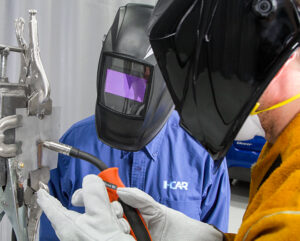
I-CAR launches initiative to address industry’s technician shorage
By onAnnouncements
The Inter-Industry Conference on Auto Collision Repair (I-CAR) announced Monday that it is launching a multifaceted initiative to address the shortage of technicians in the industry.
The core of the initiative lies in a variety of types of programming for participating schools and body shops, and the coordination of campaigns and branding directed at students.
Specifically, I-CAR outlined four primary ways in which it will be working to increase the number of qualified entry-level technicians entering the collision repair industry, and to retain those technicians. These are:
- Coordinating industry-wide efforts with like-minded partners to attract more talent through increased industry branding and targeted campaigns. These will be shared with program participant schools, repair shops and other organizations to increase reach.
- Enhancing entry-level educational programming for both career and technical education (CTE) schools and repair facilities to better prepare entry-level technicians for success. This includes mentoring and an apprenticeship programing option for both schools and Gold Class repair facilities.
- Providing additional support to CTE schools to help them make full use of new educational programming, including enhanced access to needed funding equipment and materials. This should help attract more students, and better prepare them for success at the start of their careers.
- Adding programming to help Gold Class shops, in particular, to more successfully bring in, develop, and retain technicians. This includes mentoring, and a suite of relevant human resources training and guidance on best practices.
Some components of the plan will be rolled out this year, with additional elements launching throughout 2023 and 2024, I-CAR said.
“The deepening technician shortage, exasperated by COVID-19, continues to challenge the collision repair industry amid one of the most compelling and transformative eras of automotive innovation, prompting new opportunities for the inter-industry to lean in together with an integrated, collaborative and robust approach,” I-CAR President and CEO John Van Alstyne said in a statement.
Van Alstyne told Repairer Driven News that I-CAR, as a “neutral collaboration partner,” has had the opportunity to speak with many in the industry affected by the shortage. “Over the past year or so, we’ve increased and amplified those conversations, surveyed our key stakeholders and relied on third party partner data to validate what the inter-industry has felt for quite some time – technicians leaving the industry and natural business growth are outpacing new technicians entering the industry,” he said.
“There are many contributing factors to the technician shortage. All center around the need to attract potential talent to the industry and retain that talent,” he said. “At the crux of it are, lack of public awareness around the benefits of working in collision repair, a need for better school programs that graduate more entry-level ready talent, and repair facilities that are tasked with preparing entry-level technicians from schools and general recruiting while working to retain those technicians.”
Industry experts have told Repairer Driven News that central to bringing new talent into the field are pay and benefits packages that are competitive with other industries that require similar skillsets. Van Alstyne said I-CAR plans to “benchmark compensation across the nation and similar trades and share this with our industry partners so the industry can have a fact based conversation.”
“Promoting compensation and other benefits and career paths for entry-level techs is an important part of the message to attract talent,” he said. “In our research and conversations with the industry, we’ve determined compensation varies based on many factors, and organization by organization.”
Acknowledging that other organizations are also working on recruitment, Van Alstyne said I-CAR’s goal is “not to compete with these programs, but to collaborate with and align efforts to improve efficiency and impact with organizations of like minds that are already in the space and those eager to help.” He said I-CAR has already had conversations with many of these organizations.
Van Alstyne said he believes I-CAR will be able to help the industry support and keep new talent. “We believe that the holistic solution needs to include shop mentors and school educators that help entry-level techs succeed for the long haul,” he added. “To attract and retain talent, it will be important for repair facilities to step up their people programming, and we plan to help shops that wish and commit to doing so.”
The expense to participating schools and repair facilities will be “nominal,” he said. I-CAR will be “working through those details in the coming months as full program details are further crystallized.”
The initiative is “all about I-CAR stepping up, as we believe the best positioned industry body, to help lead our industry forward on Talent,” he said. At the same time, the organization is held accountable for its financial performance by its board of directors, and must balance revenue and expenses.
The ongoing technician shortage has been well documented. According to surveys by the TechForce Foundation, the industry needs 258,000 new technicians each year, while schools are graduating only one-fifth of that number. Shops that responded to a recent I-CAR survey said that they need an average of 2.5 additional technicians.
Van Alstyne said the initiative will benefit all of the segments of the industry served by I-CAR: repairers, schools, OEMs, insurers, suppliers, and service providers.
Leading the initiative will be Dara Goroff, a 10-year veteran in collision repair, who is joining I-CAR as Vice President, Planning & Industry Talent Programming.
In a statement, Goroff said, “In reality the talent crisis and the technician shortage specifically, is a complex issue with many layers and nuances requiring an integrated approach to tackle each aspect. From recruiting and vetting to mentoring, training and retaining new talent to address the shortage, all of these components must work together and be part of a comprehensive solution.”
Goroff said I-CAR will provide regular progress updates to the inter-industry.
The Collision Repair Education Foundation (CREF) will collaborate with I-CAR in the effort, Van Alstyne said.
“Current initiative goals are centered around closing the technician shortage and continuing to support the collision repair inter-industry, with time to impact an important measure. This is great example of how I-CAR and CREF are putting industry support to work on new, significant industry issues,” he said.
Brandon Eckenrode, managing director of CREF, said the new programming initiatives “will only enhance efforts” to meet the industry’s current and future need for technicians.
“CREF looks forward to collaborating with I-CAR on this initiative and coordinating efforts to raise the level of support to high school and college collision programs and beyond across the country,” Eckenrode said.
Van Alstyne said the expense to participating schools and repair facilities will be “nominal,” and that I-CAR will be “working through those details in the coming months as full program details are further crystallized.”
The initiative is “all about I-CAR stepping up, as we believe the best positioned industry body, to help lead our industry forward on Talent,” he said. At the same time, the organization is held accountable for its financial performance by its board of directors, and must balance revenue and expenses.
I-CAR has devoted much thought to the cultural issue of parents steering their children away from the trades, and plans to “promote the collision repair industry in as many effective ways as possible” and to reach out to parents and students earlier, he said.
“There are some great programs and messages already in place by organizations within the inter-industry,” he said. “Our goal is to not reinvent the wheel, but to build on it and amplify it.”
Eliza Johnson, principal of Ducker Carlisle, recently told RDN that the industry as a whole is suffering from decreased interest among young people, low pay for the high skillset required, few benefits, and a lack of defined career paths.
“I think there’s become less interest in the field overall for people at a young age and people aren’t really getting funneled into the career like they used to be,” Johnson said. “There’s a lot of encouragement on high schoolers to go to four-year universities and much less focus on trades such as automotive.”
In a midyear update of its 2022 Crash Course report, CCC Intelligent Solutions found that the technician shortage is a “key reason” for mounting backlogs at body shops. According to the most recent data from CRASH Network, nearly 80% of collision repair shops in the U.S. are scheduling vehicle repairs out two weeks or more.
“The collision repair industry, like many industries, simply cannot find enough technicians to fill the open positions,” CCC said, citing a CollisionWeek report based on Bureau of Labor Statistics data showing that shops have raised weekly wages by a national average of 7.2% over the same quarter in 2021.
These bigger paychecks “are now translating to increased labor rates,” CCC said. It said that according to CRASH Network, “many shops” have reported approved rate increases of between 6% and 9%. CCC called this “a key factor” behind the climb in repair costs.
Repairer capacity and wages “will continue to be a headwind for some time,” CCC said.
Images
Featured image provided by I-CAR.

